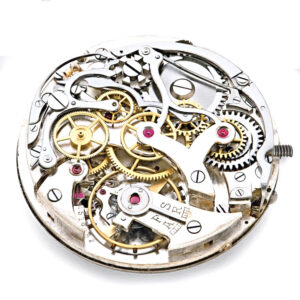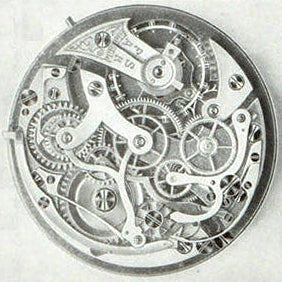 |
Brand: | Minerva | 





|
|---|---|---|---|
| Family: |
Unknown
|
||
| Height: | 7.60 mm | ||
| Jewels: | 17 | ||
| Reserve: | 32 hours | ||
| Frequency: | 18,000 A/h | ||
| Winding: | Hand winding | ||
| Diameter: | 42.15 mm (19 ligne) | ||
| Complications: | 6-Column Chronograph, 7-Column Chronograph, Chronograph, Column Wheel Chronograph | ||
| Hands: | 30 Minute Chronograph Hand at 3:00, Central 60 Second Chronograph Hand, Central Hour Hand, Central Minute Hand, Small Seconds Hand at 9:00 | ||
| Distinguishing Technical Characteristics | |||||||||||
|---|---|---|---|---|---|---|---|---|---|---|---|
 Hand-Winding  Clockwise Balance Cock  6-Column Chronograph  7-Column Chronograph |
|||||||||||
| Production: 1908 – | |||||||||||
| 1910s | 1920s | 1930s | 1940s | 1950s | 1960s | 1970s | 1980s | 1990s | 2000s | 2010s | 2020s |

Cal. 9 CH is a 19 ligne chronograph pocket watch movement from Robert Frères (later called Minerva). It was descended from Cal. 19/3, the company’s first stem-set movement, and shares with the time-only Cal. 9 and Cal. 19/27. It was introduced around 1908 and remained in production through the 1940s.
The company calls it “Chronographe-Compteur Calibre 19/9 CH” in data sheets. It was produced in monopusher (with 6 columns) or 2-pusher (with 7 columns) versions as well as with 30 or 45 minute counters. A non-chronograph version is simply called Cal. 9 or Cal. 19/9.

One distinctive element of the movement is the u-shaped arm for the oscillating pinion, which is unlike anything on any other movement. This makes Cal. 19/9 CH instantly recognizable.
Cal. 3 spawned a range of related pocket watch movements:
| Cal. 19/3 | Open face pocket watch |
| Cal. 19/9 | Open face pocket watch |
| Cal. 19/27 | Open face pocket watch |
| Cal. 19/9 CH | Crown operated chronograph |
| Cal. 19/10 | Pusher operated chronograph |
| Cal. 19/11 | Pusher operated split seconds chronograph |
